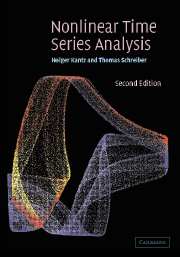Book contents
- Frontmatter
- Contents
- Preface to the first edition
- Preface to the second edition
- Acknowledgements
- I Basic topics
- 1 Introduction: why nonlinear methods?
- 2 Linear tools and general considerations
- 3 Phase space methods
- 4 Determinism and predictability
- 5 Instability: Lyapunov exponents
- 6 Self-similarity: dimensions
- 7 Using nonlinear methods when determinism is weak
- 8 Selected nonlinear phenomena
- II Advanced topics
- A Using the TISEAN programs
- B Description of the experimental data sets
- References
- Index
8 - Selected nonlinear phenomena
Published online by Cambridge University Press: 06 July 2010
- Frontmatter
- Contents
- Preface to the first edition
- Preface to the second edition
- Acknowledgements
- I Basic topics
- 1 Introduction: why nonlinear methods?
- 2 Linear tools and general considerations
- 3 Phase space methods
- 4 Determinism and predictability
- 5 Instability: Lyapunov exponents
- 6 Self-similarity: dimensions
- 7 Using nonlinear methods when determinism is weak
- 8 Selected nonlinear phenomena
- II Advanced topics
- A Using the TISEAN programs
- B Description of the experimental data sets
- References
- Index
Summary
In the preceding sections we have already discussed the properties of chaotic dynamics, namely instability and self-similarity. But nonlinear systems possess a much richer phenomenology than just plain chaos. In fact, non-chaotic motion on stable limit cycles is very typical in real world systems. Hence we devote the first section to them. Synchronisation, which is also a nonlinear phenomenon and clearly related to ordered motion, will be discussed in Section 14.3. The aspects we describe in the following sections can be roughly divided into two classes. The first consists of problems we may have with the reproducibility or stationarity of the signal even though all system parameters are kept fixed. Examples are transient behaviour and intermittency. The other group comprises what can happen under changes of the parameters. We will discuss the various types of attractor and how transitions between them occur, the bifurcations.
Robustness and limit cycles
When speaking of nonlinear dynamics, the immediate associations are bifurcation scenarios and chaos, i.e., the sensitivity of solutions either to small changes of the system parameters or to small perturbations of the system's state vector. What is often overlooked is that a much more typical feature of nonlinear systems is the existence of stable limit cycles, which are often very robust against all kinds of perturbations.
When observing a periodic signal, a Fourier transform may be a very good representation of its features. As is well known, the power spectrum (or the auto-correlation function, respectively), uniquely determines the corresponding linear model.
Information
- Type
- Chapter
- Information
- Nonlinear Time Series Analysis , pp. 126 - 140Publisher: Cambridge University PressPrint publication year: 2003
Accessibility standard: Unknown
Why this information is here
This section outlines the accessibility features of this content - including support for screen readers, full keyboard navigation and high-contrast display options. This may not be relevant for you.Accessibility Information
- 3
- Cited by
